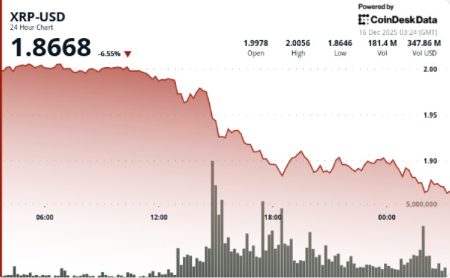New Research Reveals Bitcoin’s $6 Billion Vulnerability: How Secure Is the World’s Leading Cryptocurrency?
Duke University Study Uncovers Alarming Weaknesses in Bitcoin’s Security Infrastructure
In a groundbreaking analysis that has sent ripples through cryptocurrency markets, researchers from Duke University have uncovered a sobering reality about Bitcoin’s vulnerability to what experts call a “51% attack.” The research suggests that the world’s premier cryptocurrency network could potentially be compromised for approximately $6 billion—a figure significantly lower than previous security estimates and one that raises fundamental questions about the resilience of blockchain technology.
The study, spearheaded by finance scholars at Duke’s Fuqua School of Business, meticulously examined the cost barriers that would face potential attackers seeking to gain majority control of Bitcoin’s mining power. Contrary to conventional wisdom in cryptocurrency circles, which has long held that Bitcoin’s massive network creates prohibitive costs for would-be attackers, the research team discovered several attack vectors that substantially lower these barriers. By leveraging existing market mechanisms like futures contracts and strategic mining equipment acquisition, a determined entity with sufficient capital could potentially orchestrate a network takeover for far less than previously thought.
“What we’re seeing is a fundamental misunderstanding of Bitcoin’s security model in the broader market,” explained the study’s lead researcher. “The conventional narrative suggests that Bitcoin’s security scales with its market capitalization, which currently hovers around $1 trillion. Our analysis demonstrates that the actual security threshold is closer to one-half of one percent of that figure—creating a concerning disconnect between perceived and actual security.” This revelation comes at a particularly sensitive time for cryptocurrency markets, which have weathered several high-profile security breaches on smaller blockchains but have generally considered Bitcoin itself largely impervious to such attacks due to its scale and decentralized structure.
Understanding the Mechanics of a 51% Attack and Its Devastating Implications
A 51% attack represents the cryptocurrency equivalent of a nuclear option—a scenario where a single entity or coordinated group gains control of more than half of a network’s mining power, allowing them to manipulate transactions, prevent confirmations, and potentially execute “double-spending” of coins. While theoretical discussions of such attacks have circulated in cryptographic circles for years, they’ve largely been dismissed as economically irrational for major networks like Bitcoin. The Duke research challenges this assumption by outlining how, through a combination of mining hardware acquisition and sophisticated market plays on Bitcoin futures, an attacker could not only execute such an attack but potentially profit from it.
The researchers modeled several attack scenarios, including what they term “settlement attacks” that target the trillion-dollar futures market rather than the underlying blockchain itself. “By simultaneously taking short positions in Bitcoin futures while preparing to disrupt the network, an attacker creates a self-fulfilling prophecy,” the research team noted. “The market panic resulting from evidence of centralized control would likely trigger a price collapse, allowing the attacker to profit from their short positions—potentially offsetting much of their attack costs.” This dual-pronged approach transforms what was previously considered an economically irrational attack into one with a potentially viable profit motive, particularly for nation-states or extremely well-resourced adversaries who might have strategic rather than purely financial motivations.
What makes the research particularly concerning is its assessment of the practical requirements for mounting such an attack. The team calculated that an attacker would need to acquire approximately 4-5% of the global semiconductor manufacturing capacity dedicated to producing mining equipment over a two-year period—a substantial but not impossible feat for a determined adversary with deep pockets. “When we consider that certain nation-states already control significant portions of global semiconductor production, the barrier doesn’t seem as insurmountable as the crypto community has assumed,” warned one of the study’s co-authors. The research also highlighted how the geographic concentration of mining operations, with significant clusters in regions like North America and previously in China, creates additional vulnerability points that could be exploited.
Market Reactions and Industry Responses to the Security Revelation
The cryptocurrency market’s response to the Duke findings has been measured but cautious, with Bitcoin experiencing modest downward pressure as investors digest the implications. Industry veterans and blockchain security experts have offered varied perspectives, with some dismissing the research as theoretical while others acknowledge it represents a legitimate security concern that requires addressing. “What we’re seeing is the natural evolution of security analysis in a maturing asset class,” noted a prominent cryptocurrency exchange security director. “Every financial system has theoretical vulnerabilities—what matters is how the ecosystem responds to strengthen its defenses.”
Bitcoin core developers and mining pool operators have publicly addressed the research, pointing to ongoing efforts to enhance network security and resilience against potential attacks. Several have highlighted that the theoretical vulnerability identified by the Duke researchers would still require extraordinary resources and coordination to execute successfully, with significant risks for the attackers. “The beauty of open-source technology is that identified vulnerabilities lead to improved security models,” explained a longtime Bitcoin core contributor. “This research will likely accelerate discussions around potential protocol modifications that could further raise the cost of such attacks and enhance detection of suspicious mining concentration.”
Institutional investors, who have increasingly embraced Bitcoin as a legitimate asset class over the past several years, appear to be taking a wait-and-see approach. “We’re carefully evaluating the technical merits of the research,” stated the chief investment officer at a digital asset management firm with significant Bitcoin holdings. “While the theoretical attack vector is concerning, we believe the practical challenges of executing such an attack, combined with the likelihood of community response measures, maintain Bitcoin’s position as a secure store of value.” Several institutional investors have indicated they are consulting with security researchers to better understand the implications of the Duke study and whether it necessitates adjustments to their risk models for cryptocurrency exposure.
Broader Implications for Blockchain Security and the Future of Cryptocurrency Adoption
The revelations about Bitcoin’s potential vulnerability raise profound questions for the entire cryptocurrency ecosystem, particularly as financial institutions and governments worldwide continue exploring blockchain adoption. If the flagship cryptocurrency can be theoretically compromised for a relatively modest sum relative to its market capitalization, similar concerns may apply to smaller blockchain networks with correspondingly lower security thresholds. This could accelerate the ongoing consolidation within the cryptocurrency space, as investors and users gravitate toward networks with the strongest security guarantees and most robust governance structures.
Regulatory implications may prove equally significant, as financial watchdogs have consistently cited security concerns as justification for cautious approaches to cryptocurrency integration within traditional financial systems. “This research provides empirical support for regulators who have expressed skepticism about cryptocurrency security models,” observed a former financial regulator now consulting on digital asset policy. “We may see this study cited in upcoming regulatory frameworks as evidence that additional security safeguards are needed before wider institutional adoption can proceed.” Several congressional offices and regulatory bodies have already requested briefings on the study’s findings, suggesting its impact may extend beyond academic and industry circles into the policy domain.
Despite these challenges, many blockchain experts see the research as an opportunity rather than simply a cause for alarm. “Identifying security weaknesses is the first step toward addressing them,” emphasized a blockchain security researcher unaffiliated with the Duke study. “The history of internet security followed a similar pattern—early vulnerabilities led to stronger systems, not abandonment of the technology.” Several cryptocurrency projects are already exploring innovative consensus mechanisms and security models that could potentially address the vulnerabilities identified in the research, including hybrid approaches that combine the benefits of proof-of-work systems like Bitcoin’s with newer security models that don’t rely exclusively on mining power as their security foundation.
As the dust settles on this landmark security analysis, one thing remains clear: the $6 billion figure identified by Duke researchers will likely serve as a wake-up call for an industry that has sometimes prioritized growth and adoption over security fundamentals. Whether this leads to meaningful protocol improvements, regulatory interventions, or simply more nuanced risk assessments from investors remains to be seen—but the cryptocurrency landscape has been permanently altered by this sobering reassessment of Bitcoin’s security foundation.















